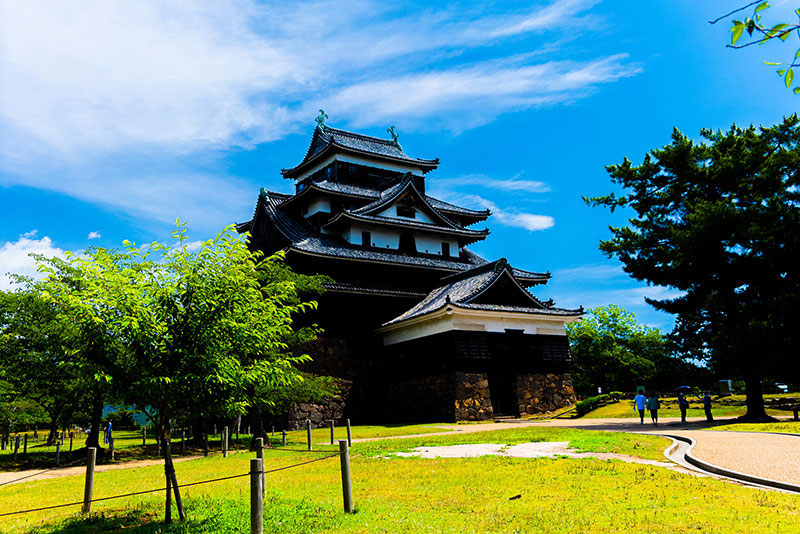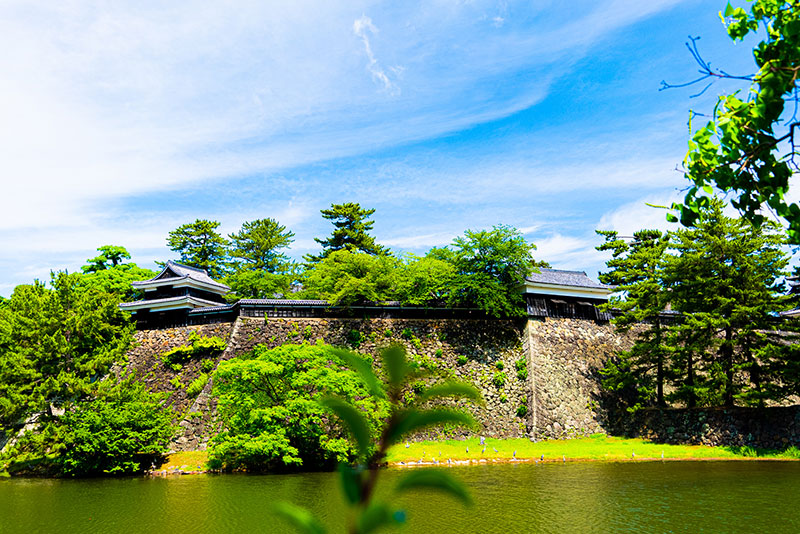Matsue CastleMatsue Castle's exquisite location and size make it irresistible
There are 12 castle towers left in Japan. ``Existing castle towers'' are castle towers that were built during the Edo period or earlier and have been preserved until the present day, although there are many castles that have been abandoned, destroyed by fire, or destroyed in wars such as the Pacific War. is.
Matsue Castle is one of the 12 remaining castle towers in present-day Matsue City, Shimane Prefecture. There are also beautiful Himeji Castles called Hikone Castle and Shirasagi Castle, but I really like Matsue Castle and always mention it when I'm asked, ``What's your favorite castle?''
This time, I would like to talk about why I love Matsue Castle.
Reason #1: The size of the castle
In addition to the main castle, the large castle is made up of many buildings such as Ninomaru, Sannomaru, garden, and a turret, and has a vast site. A large castle is dynamic in itself and stands out even from a distance, so I think it probably fulfilled its role as a symbol of the town at the time.
In comparison, Matsue Castle is not that big.
Matsue Castle's castle tower has four floors on the outside, five floors on the inside, and one floor underground. A one-story attached turret with a basement floor is attached to the south of the castle tower.
Formally, the castle is classified as a ``watchtower-type castle tower,'' with a double (three-story) watchtower placed on top of a double turret. The double and fourth floors are built with gables on the east and west sides, and one of the key features is the bay windows on the north and south sides of the double floors.
The attached turret is also of irimoya-zukuri construction. The walls are covered with black clapboard on the first and second floors, and the tops of the third and fourth floors and attached turrets are plastered, and the bottom is covered with black clapboard.
The walls of the north and south bay windows are plastered. All the roofs are made of real tiles, and I really like the fact that they use a lot of pillars that span the two floors. In the center of the building, there are through columns that connect the basement and first floor, second and third floors, and fourth and fifth floors, and outside parts such as side columns connect the first and second floors, and the third and fourth floors. A through post is used.
Large castles take a lot of time and energy to look around, but one of the reasons I like it is that something the size of Matsue Castle can be seen without any hesitation.


Reason 2: Location and shape
The castle has various locations. Depending on the purpose of building a castle, there are various types of castles, including mountain castles built on solid mountains that aim to be impregnable, and castles that take advantage of terrain such as rivers.
I'm sure the location had some significance when the castle was built. However, in modern times, touring a mountain castle takes a lot of physical strength and time, and it also seems to require a lot of determination, so just going there can make you feel like you have to be prepared...
In that respect, Matsue Castle's shape is similar to that of a flat castle. The original size of the building does not remain, and today there is a shrine in the Kitanomaru area and the Shimane Prefectural Office in the Sannomaru area.
Located in the northern part of the city of Matsue, it is easily accessible and is a flat-lined complex-type Hirayama Castle with the Kyobashi River flowing to the south as its outer moat.
Built on Kamedayama on the northern shore of Lake Shinji, it is considered one of Japan's three great lake castles, and one of my favorite points is that the Horikawa River that surrounds the castle is connected to Lake Shinji.
Since it is connected to Lake Shinji, the moat has a rare shape with thin salt water (brackish water).
The structure is centered around the Honmaru, with the Kitanomaru to the north, the upper Ninomaru to the south, the lower Ninomaru to the east, and the Sannomaru, which is independent and relatively compact, located further south of the upper Ninomaru, like a castle. The central palace of the castle seems to have been placed in the upper part of the Ninomaru, but due to the narrowness of the site, a palace was also built in the Sannomaru. It is said that successive feudal lords mainly lived here. Only the stone wall remains of Otemon, but it forms a huge square.
The legend of the human pillar that remains at Matsue Castle
It is said that Matsue Castle collapsed many times because the stone walls of the castle tower could not be built.
It is said that the innovators involved in the construction said, ``The construction work cannot be completed without human pillars,'' and when a Bon dance was held, the most beautiful girl among them and the best dancer was sacrificed. It is said that the girl was kidnapped during a dance and buried for unknown reasons.
As a result, the stone wall was completed beautifully and the castle was successfully completed, but the father and son who owned the castle suddenly died and the castle was abandoned. The people feared that it was the curse of their daughter's regrets, and the castle tower was left in disrepair. After that, there is a legend about the castle that sobs could be heard coming from the castle tower until the Matsudaira clan entered the castle.
Furthermore, there is a story in Yakumo Koizumi's ``The Girl Who Was Made a Human Pillar'' that the Bon dance was not held in the castle town because of the legend that ``the castle would shake.''
Also, when the stone wall in the northeast part of the castle tower was in trouble because it had collapsed many times, an old friend of Yoshiharu Horio, a komuso monk, appeared and when he had him dig in the collapsed area, a skull with a spear stuck in it came out. Komuso prayed, but there was still some danger. The Komuso said, ``Prayers won't do it,'' so I asked him what he should do, and he replied, ``If you want my son to serve in the government, I'll become the Jinbashira,'' so he asked the Komuso to become the Jinbashira and restarted the construction work. Although it was possible to do so, the Horio family died out during the construction work under the second generation, Tadaharu.
There are also various other legends that say that when he heard the shakuhachi of a komuso, he captured him and made him into a human pillar, and then he began to hear the sound of the shakuhachi.
This kind of legend is also one of the reasons why I feel sad and drawn to it. I would like to visit Matsue Castle again soon.
- Article category
- my favorite castle
- Related castles, temples and shrines
Matsue Castle
National treasure tower

- introducerTomoyo Hazuki (writer)I have loved history and geography since my student days, and have enjoyed visiting historical sites, temples and shrines, and researching ancient documents. He is especially strong in medieval Japanese history and European history in world history, and has read a wide range of things, including primary sources and historical entertainment novels. There are so many favorite military commanders and castles that I can't name them, but I especially like Hisashi Matsunaga and Mitsuhide Akechi, and when it comes to castles, I like Hikone Castle and Fushimi Castle. Once you start talking about the lives of warlords and the history of castles, there's a side of you that can't stop talking about them.

